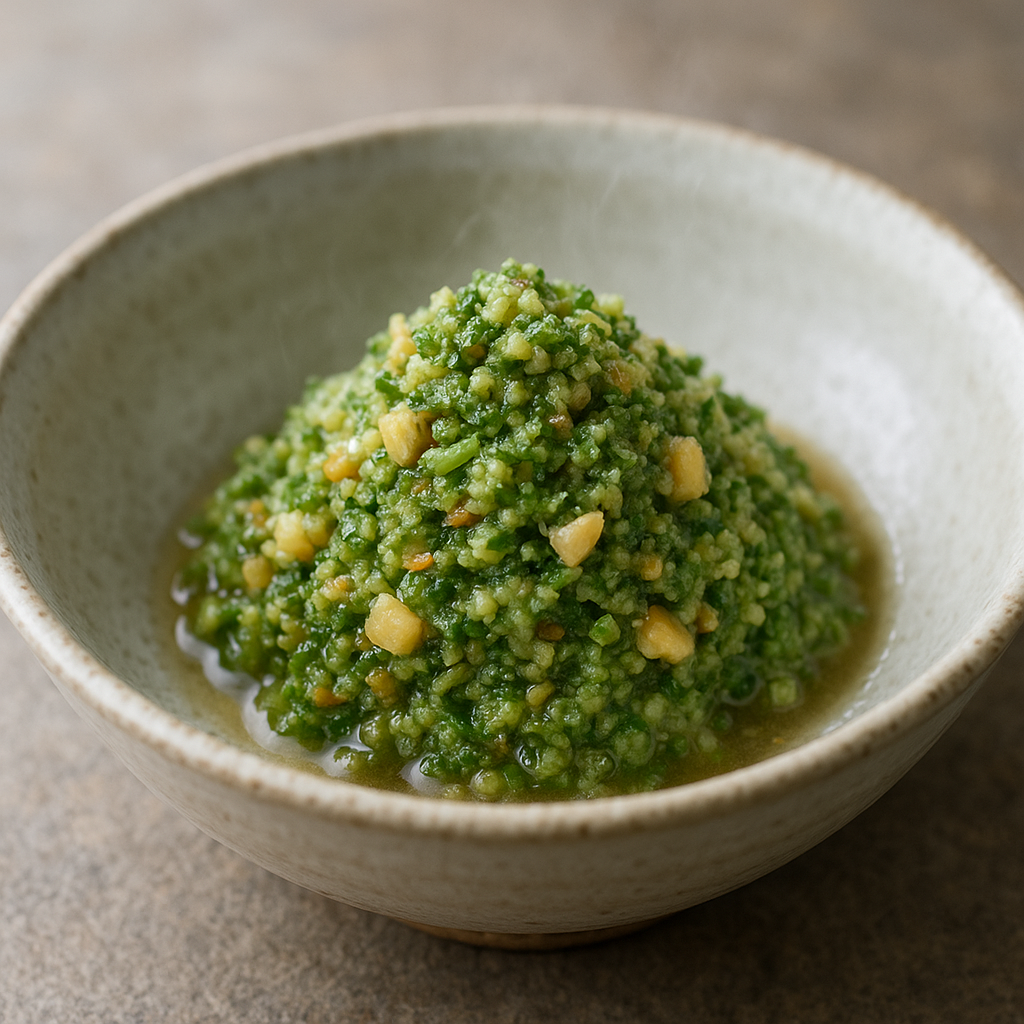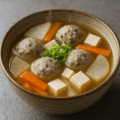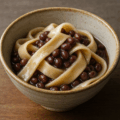うこぎのほろほろ(岩手)の特徴
うこぎ×味噌漬け大根×くるみの“ふりかけ”仕立て
「うこぎのほろほろ」は、春に摘んだうこぎの若芽をさっとゆでて刻み、味噌漬け大根とくるみを細かくして混ぜ合わせ、ご飯にのせていただく郷土の味です。うこぎのほろ苦さ、味噌漬けの塩け、くるみのコクが一体となり、素朴ながら箸が進みます。
“ほろほろ”の名はこぼれ落ちる食感に由来します
細かく刻んだ具が箸から“ほろほろ”とこぼれやすい様子から名が付いたと伝えられます。岩手では生け垣としてうこぎを植える風習が残り、旬の時季に家庭で作られています。
うこぎのほろほろ(岩手) レシピ
材料(作りやすい分量・約5人分)
- うこぎ(若芽) … 75g
- 味噌漬け大根 … 50g(細かめの角切りにする)
- くるみ(むき身) … 100g(粗く刻む)
- しょうゆ … 小さじ1〜2(風味付け)
- 塩 … 少々(味を見て)
- (お好みで)白ごま … 大さじ1
- (彩りに)にんじん極細みじん/赤なんばん少量 … 適宜
作り方
- 1. うこぎは塩少々を加えた熱湯で30〜40秒ゆで、冷水にとる。固く絞って水気を切り、細かく刻む。
- 2. 味噌漬け大根・くるみをそれぞれ細かく刻む(食感を残すなら粗みじん)。
- 3. ボウルでうこぎ・味噌漬け大根・くるみを混ぜ、しょうゆで風味付け。味を見て塩で微調整。
- 4. 好みで白ごまやにんじん・赤なんばんのみじん切りを加えて混ぜる。
- 5. 温かいご飯にのせて供する。保存は清潔な容器で冷蔵(目安2〜3日)。
シェフのワンポイントアドバイス
- うこぎは硬めにゆでて素早く冷やすと、色と香りが生きます。水気はしっかり絞ると日持ちが良くなります。
- 塩味の基調は味噌漬け大根にあります。しょっぱめの漬物なら、しょうゆは控えめに。
- 普通の大根で代用する場合には角切りにした後、塩もみをし、水気を絞ってから使用。
- くるみは炒らずに使うとまろやか、軽く乾煎りすると香ばしさが立ちます。
栄養価(1人分の目安)
- エネルギー … 90〜150 kcal
- たんぱく質 … 2〜4 g
- 脂質 … 7〜12 g(くるみ由来)
- 炭水化物 … 3〜6 g
- 食物繊維・ポリフェノール・ビタミンC … うこぎ・くるみ・漬物由来
歴史
“食べられる生け垣”として根づいたうこぎの文化
うこぎは岩手や山形で生け垣として植えられ、春の若芽を食用にしてきました。救荒食としての歴史を持ちながら、栄養にも富む山菜として親しまれています。
刻む所作が生む郷土の味わい
若芽・味噌漬け・くるみを細かく刻んで和える家庭料理として伝わり、箸から“ほろほろ”とこぼれる食感に名前の由来があると語り継がれています。ご飯はもちろん、焼きおにぎりやパンに挟んでもおいしくいただけます。
English Version
Features of Ukogi no Horohoro (Iwate)
A “sprinkle” mix of ukogi + miso-pickled daikon + walnuts
Ukogi no horohoro is a homestyle topping made by briefly blanching spring ukogi shoots, chopping them finely, and mixing with minced miso-pickled daikon and chopped walnuts. The gentle bitterness of ukogi, salty depth of the pickle, and nutty richness come together beautifully over warm rice.
“Horohoro” refers to the crumbly texture
The name evokes how the fine bits “horohoro”—crumble and fall—off the chopsticks. In Iwate, ukogi hedges are still common, and families prepare this dish in season.
Ukogi no Horohoro (Iwate) – Recipe
Ingredients (about 5 servings)
- Ukogi (young shoots) … 75 g
- Miso-pickled daikon … 50 g (finely diced)
- Walnuts, shelled … 100 g (coarsely chopped)
- Soy sauce … 1–2 tsp (to season)
- Salt … a pinch (to taste)
- (Optional) White sesame … 1 Tbsp
- (For color) Very finely minced carrot / a little red chili … as desired
Directions
- 1. Blanch ukogi in salted boiling water for 30–40 seconds; shock in cold water. Squeeze very well and mince finely.
- 2. Mince miso-pickled daikon and walnuts (leave slightly coarse if you like texture).
- 3. Combine ukogi, pickled daikon, and walnuts in a bowl; season with soy sauce. Adjust salt to taste.
- 4. Mix in white sesame and a little minced carrot or red chili if desired.
- 5. Serve over warm rice. For storage, keep in a clean container in the fridge for 2–3 days.
Chef’s Tips
- Blanch ukogi briefly and chill fast to preserve color and aroma; squeeze out moisture thoroughly for better keeping.
- The salt base comes from the pickled daikon; if it’s quite salty, go light on soy sauce.
- If substituting fresh daikon: dice → salt-rub → squeeze well, then season to taste before mixing.
- Untoasted walnuts give a mellow tone; lightly toasting boosts aroma.
Nutrition (per serving, approx.)
- Energy … 90–150 kcal
- Protein … 2–4 g
- Fat … 7–12 g (mostly from walnuts)
- Carbohydrates … 3–6 g
- Fiber, polyphenols, vitamin C … from ukogi, walnuts, and pickles
History
An “edible hedge” tradition
Ukogi hedges have long been planted in Iwate and Yamagata; spring shoots are harvested for food. Once valued as a famine food, ukogi is now appreciated as a nutritious wild vegetable.
Fine chopping as a hallmark of home taste
Families passed down the practice of finely chopping young shoots, pickles, and walnuts, yielding the signature “horohoro” crumble. It’s delicious on rice—and also on grilled rice balls or tucked into bread.



何でも質問してください!